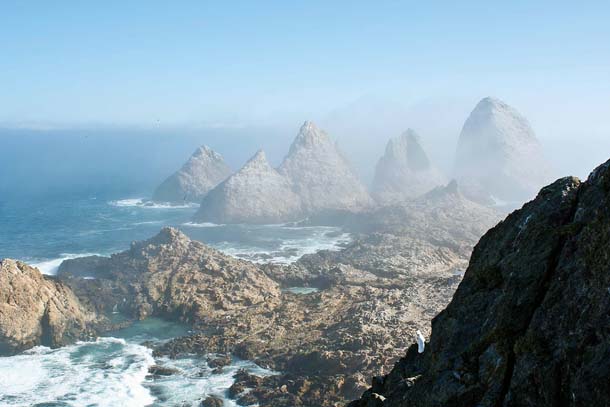You’ll likely smell them before you see them: A rich ammoniac scent engulfs our boat, and then they loom out of the fog – spires of naked rock, eerily lunar in configuration. And as they emerge, there’s an aural accompaniment: the cackles and squawks of hundreds of thousands of seabirds, with the bellows of thou-sands of pinnipeds providing a bass counterpoint.
These, of course, are the Farallon Islands. About 30 miles west of the Golden Gate, this aggregation of granitic islets is a wildlife refuge of global significance. Thirteen species of marine birds breed here; the is-lands’ nesting colonies of western gulls and ashy storm petrels are the largest in the world. Five pinniped species – California sea lion, Steller sea lion, northern fur seal, northern elephant seal, and harbor seal – maintain rookeries on these rocky and constricted shores.
But the Farallones are just the tip of the bio-berg, as it were, a small and visible manifestation of a great trove of pelagic life hidden under the surface of the ocean’s swells. Situated in the middle of the California Current, the islands and their surrounding waters are beneficiaries of upwelling, the wind-driven marine phenomenon that transports cold, nutrient-laden abyssal water close to the surface, establishing the basis for a food web that is one of the richest on the planet. Nourished by upwelling, zooplankton by the kiloton feed the krill and anchovies that in turn sustain the birds and pinnipeds of the Farallones, as well as great numbers of rockfish, salmon, and cetaceans in adjacent waters.
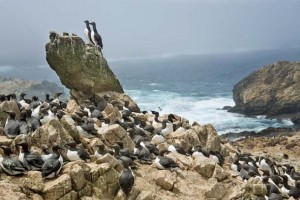
The location of this biological treasure trove just off the coast of the Bay Area – as replete with research institutions as any place on earth – has made the Farallones a living marine laboratory, a subject of study by scientists for decades, foremost among them researchers from Petaluma-based PRBO Conservation Science. PRBO’s daily logs reach back to 1968, allowing researchers to track both yearly variability and long-term trends in wildlife, fisheries, and oceanic conditions. These detailed datasets point to significant changes for the Farallones and the surrounding seas, changes driven by a shifting climate that threaten to disrupt the region’s biological productivity.
In the past, the Farallones were menaced by direct assaults: egg collection for San Francisco’s restaurants in the 1850s and ’60s; fishermen shooting sea lions; the military dumping barrels of radioactive waste in adja-cent waters after World War II. These threats were straightforward, as was the solution: declaring the is-lands a national wildlife refuge managed and protected by the U.S. Fish and Wildlife Service. Climate change, on the other hand, is neither localized nor easily addressed: The collapse of zooplankton from re-duced upwelling due to a changing climate, for example, is both impossible to predict with accuracy and hellishly difficult to mitigate.
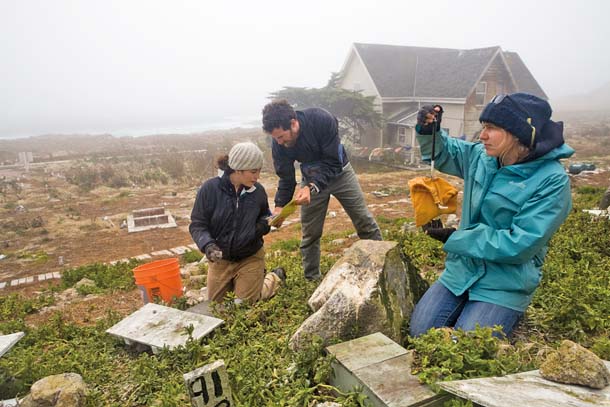
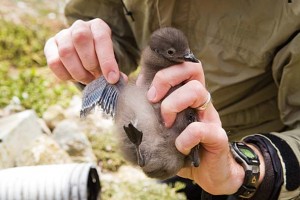
The impacts of climate change are already being felt, though this wasn’t immediately apparent on a re-cent visit to Southeast Farallon Island, the largest islet in the archipelago and the site of PRBO’s research station. On a windy, fog-shrouded spring day, thousands of nesting western gulls crowded pathways on a flat expanse known as the Marine Terrace, vocalizing querulously and pecking at researchers’ ankles. Nearby at Sea Lion Cove, California and Steller sea lions jockeyed for territory with nesting colonies of Brandt’s cormorants and common murres. Small holes marking the nest burrows of Cassin’s and rhinoceros auklets were everywhere, as were fabricated nesting boxes constructed by PRBO scientists. The boxes were con-structed to both expand potential nesting sites for the auklets and provide easy access for study. As we watched, researchers moved among the boxes, carefully extracting and weighing soot-gray Cassin’s auklet chicks, then returning them to their nests. It was gratifying work because “hatching success has been very high this season and the chicks are gaining weight,” says Russell Bradley, senior scientist and manager of PRBO’s Farallon program.
“Cassin’s auklets feed exclusively on krill, and krill are extremely abundant this year,” explains Bradley. “So things are looking really good for these guys. In the past two years many birds had double clutches – raising a second brood after a successful first one – and we’re beginning to see second broods this year. This is the first time in over 40 years we’ve seen such a high percentage of double broods. They’re going gangbusters.”
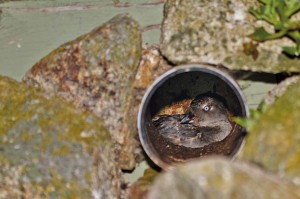
The future for the islands’ Cassin’s auklets might therefore seem bright. But PRBO’s 44-year-long re-cords for the auklets and other Farallon birds tell a different story, one that is helping researchers trace the impact of climate change on both the islands and the ocean at large: Since the 1970s, observes Bradley, Cas-sin’s auklets have declined 80 percent here. “There may have been up to 100,000 breeding Cassin’s auklets here in the early 1970s,” says Bradley. “Now there are no more than 20,000.”
With a global population of about three million ranging from Alaska to Baja California, Cassin’s auklets are not in imminent peril of extinction. But their waxing and waning says a lot about marine productivity in general. And what it says now is that coastal ecosystems are in dangerous flux. Indeed, the auklets’ recent nesting success comes after the disastrous 2005–2006 seasons, when successful breeding was virtually nil. Adults abandoned their nests en masse after laying eggs, largely because they had nothing to feed the chicks; the krill population had collapsed. The situation is similar for the island’s common murres, another species recovering from poor nesting results in 2005–2006. Unlike Cassin’s auklets, brooding murres primarily feed their chicks juvenile rockfish and other small schooling fish; but young rockfish also disappeared during this period. Researchers peg both declines to an anomalous cessation of the seasonal winds that drive upwelling.
That particular dip in upwelling wasn’t necessarily directly attributable to climate change. The problem is that global warming computer models predict much greater variability in winds and upwelling, and that, says Jaime Jahncke, director of PRBO’s California Current Group, is precisely what we’re seeing now. “We’ve had very strong upwelling since 2008. In fact, 2010 was the best year ever in terms of zooplankton production. But this follows those terrible 2005–2006 seasons.”
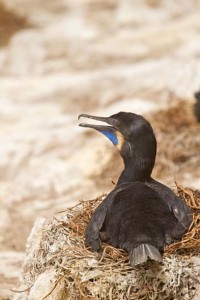
This is a recent phenomenon, emphasizes Jahncke: “The variability in Cassin’s auklet productivity on the Farallon Islands in the new millennium has been extreme. Within four years, we went from the least pro-ductive years on record to the highest. Auklet productivity in these years was associated with similar changes in seasonal onshore winds and upwelling. This contrasts with the very low variability in auklet productivity from the 1970s to the early 1980s. We believe that the Cassin’s auklets are telling us that the system has changed from one that was highly predictable to one that is almost chaotic.”
The increasing unpredictability of upwelling has been accompanied by an unexpected shift in the abun-dance of both forage species and their predators. For decades, strong upwelling was an indicator of uniform breeding success for all Farallones birds. But now forage species sometimes follow divergent paths, and up-welling no longer automatically assures their abundance. Specific causes for the fluctuations are unclear, says Jahncke, but climate change appears to be the main driver.
“Cassin’s auklets have been doing great since 2008. The same with salmon; they were down drastically from 2006 to 2009, but have come back dramatically, and the link to upwelling and abundant krill is strong. So given past data, you’d also expect anchovy eaters like Brandt’s cormorants to be thriving. After all, with upwelling, there should be plenty of anchovies.” But for reasons not yet understood, the anchovies have vir-tually disappeared off the Northern California coast, observes Bradley, and Brandt’s cormorants are in steep decline as a result. “Before 2008, we had 20,000 Brandt’s cormorants nesting on the Farallones,” Bradley says. “Now there’s maybe 2,000 to 4,000. There just isn’t the prey to sustain them.” Western gulls, another species that prefer to feed fish to their nestlings, are also having little breeding success on the Farallones this year.
Climate change is expected to exert other dramatic effects on the Farallones. Marine acidification is a particular concern. As greenhouse gas levels climb, oceans act as carbon sinks, absorbing carbon from the atmosphere. This ultimately lowers the pH of the seawater, interfering with the shell-making ability of marine organisms, including pteropods, the free-floating, minute, snail-like creatures that constitute a signifi-cant component of the zooplanktonic biomass. “The impact on them would certainly have profound conse-quences,” says Jahncke. “Anything that affects zooplankton will affect everything else along the food web.”
Finally, global warming is already causing higher sea levels: The sea level at the Golden Gate, for exam-ple, has risen by seven inches over the past century, the result of thermal expansion of seawater from rising temperatures. And the continued elevation of sea level is assured, due to both ongoing thermal expansion and the melting of the polar ice caps. The impact of these rising seas at the Farallones is both clear and ominous: less real estate for wildlife. According to a recent study by the National Academy of Sciences, West Coast sea levels could rise three feet by the end of the century. With even a “modest” rise of 1.6 feet, observes Bradley, Southeast Farallon would lose about six acres of habitat, or five percent of the island’s surface area. Much of the loss would consist of intertidal areas and the pocket beaches and gulches where pinnipeds haul out. This would force seals and sea lions onto the higher terraces where birds currently breed. Nesting habitat would thus be reduced; especially hard hit would be burrowing species, most notably Cassin’s auklets.
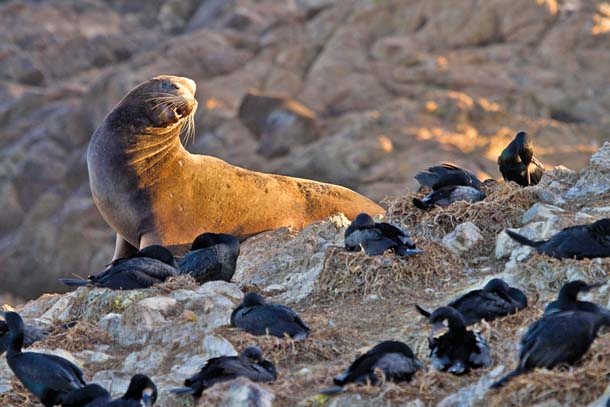
This process already appears to be under way. “In the last two years California sea lions are hauling out much higher up than usual,” says Peter Warzybok, a PRBO Farallon program biologist. “They’re now in-truding into the Brandt’s cormorant colonies.” This new behavior is apparent from a small blind at the cove. Directly in front of the blind, common murres placidly incubate their eggs on the bare rock. Fifty yards downslope, however, stressed Brandt’s cormorants hiss and peck at a California sea lion that wanders oblivi-ously among their nests. “It’s clear that sea level rise is going to result in a lot of species displacement,” says Warzybok. “The seabirds are probably going to lose out. They can’t compete against sea lions.”
So what can be done to preserve the stunning diversity of the Farallones and surrounding waters? “There are mitigation strategies that could help somewhat,” observes Bradley. The nesting boxes for Cassin’s auklets are one such mitigation, as are the tough regulations that keep casual visitors off the islands and proscribe harming or harassing marine wildlife. Gerry McChesney, manager of the refuge for the USFWS, notes that “a few species of invasive plants introduced mainly by past island occupants are affecting habitat for sea-birds and other native wildlife on the island. While we’ve been working to reduce the cover of these species for several years, a more intensive effort is needed to restore the island’s native plant community.”
Ultimately, such mitigative measures are just that: attempts to ameliorate local damages caused by trends that are planetary in scope. The sober reality is that the threats facing the Farallones, and our marine envi-ronment, can only be definitively addressed by coordinated international efforts. If nothing else, though, the rich data yielded by the Farallones and their surrounding waters are contributing to our understanding of the profound impacts climate change is exerting on our oceans. And with any luck, that understanding will provide some impetus for comprehensive action.
“Dispatches from the Home Front” is a series of articles highlighting groundbreaking work being done by Bay Area institutions, agencies, and nonprofit groups to comprehend, mitigate, and adapt to the impact of climate change on Bay Area ecosystems. The series is a partnership with the Bay Area Ecosystem Climate Change Consortium (baeccc.org). More at baynature.org/climate-change.
Funding for “Dispatches From the Home Front” has been provided by the State Coastal Conservancy, The Na-ture Conservancy, and Pacific Gas & Electric Company.

